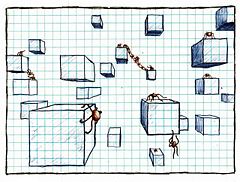Collective phenomena in economy and society: Difference between revisions
(Overall) |
No edit summary |
||
| Line 33: | Line 33: | ||
Our goal is to develop a framework in which to describe critical properties associated with classical and quantum phase transitions; and at the same time to emphasize the importance and role played by symmetry and topography. | Our goal is to develop a framework in which to describe critical properties associated with classical and quantum phase transitions; and at the same time to emphasize the importance and role played by symmetry and topography. | ||
# Mass action (sociology), in sociology, a term for situations in which a large number of people behave simultaneously in similar ways individually and without coordination | |||
# Mass action (physics), in statistical physics, the proposition that a large number of small units acting randomly may compose a larger pattern | |||
==Physics== | ==Physics== | ||
* Solitons | * Solitons | ||
| Line 42: | Line 46: | ||
==Economy== | ==Economy== | ||
===formation of nations=== | |||
===languages=== | |||
===religions=== | |||
condensation of vapor into liquid droplets | |||
==Society== | ==Society== | ||
| Line 50: | Line 57: | ||
===Game Theory=== | ===Game Theory=== | ||
===Statistical Physics, Agent Based Models | ===Statistical Physics===, | ||
===Agent Based Models=== | |||
===Complex Networks Theory=== | |||
===Cooperation=== | |||
===Revolution - cultural conflicts=== | |||
and problems of social consensus are examples of phenomena being addressed. | |||
==Other Examples== | ==Other Examples== | ||
Revision as of 23:33, 21 April 2009
“ Ah, the reason we all majored in physics in the first place... ”
| ||||||||||
Also known as mass action, collective behavior, and artificial chemistry. Strong interactions such as those in macroscopic systems frequently induce transitions and lead to new equilibrium phases of matter. These phases exhibit their own chqaracteristic fluctuations or elementary excitations known as collective modes. Although a description of these phenomena at the microscopic level can be quite complicated, the important large scale, or longtime hydrodynamic behavior is often is often simple to describe.
Phenomenal approaches based on this concept have led to certain quantum as well as classical field theories that over recent years have played a major role in shaping our understanding of condensed matter and high energy physics.
Our goal is to develop a framework in which to describe critical properties associated with classical and quantum phase transitions; and at the same time to emphasize the importance and role played by symmetry and topography.
- Mass action (sociology), in sociology, a term for situations in which a large number of people behave simultaneously in similar ways individually and without coordination
- Mass action (physics), in statistical physics, the proposition that a large number of small units acting randomly may compose a larger pattern
Physics
- Solitons
- Perturbation theory in quantum mechanics
- Ising Model
- The quantization of magnetic flux in a superconductor
- quantum Hall effect are both collective phenomena associated with thermodynamically large numbers of particles.
Economy
formation of nations
languages
religions
condensation of vapor into liquid droplets
Society
Society shows sometimes abrupt changes - revolutions - which are related to phase transitions: both are sudden and dramatic changes of behavior.
Social systems are prominent examples of complex systems. Concepts, tools and models aiming at identifying generic mechanisms underlying collective phenomena in these systems are developed with the use of
Game Theory
===Statistical Physics===,
Agent Based Models
Complex Networks Theory
Cooperation
Revolution - cultural conflicts
and problems of social consensus are examples of phenomena being addressed.
Other Examples
Animal Magnetism, like Herding
References
- http://www.santafe.edu/research/topics-dynamics-human-behavior-institutions.php
- Soft Condensed Matter, by Richard A. L. Jones (Oxford University Press, 2007).
- Solid State Physics, by J. R. Hook and H. E. Hall (Wiley, 2007).
- http://www.tcm.phy.cam.ac.uk/~bds10/phase.html

